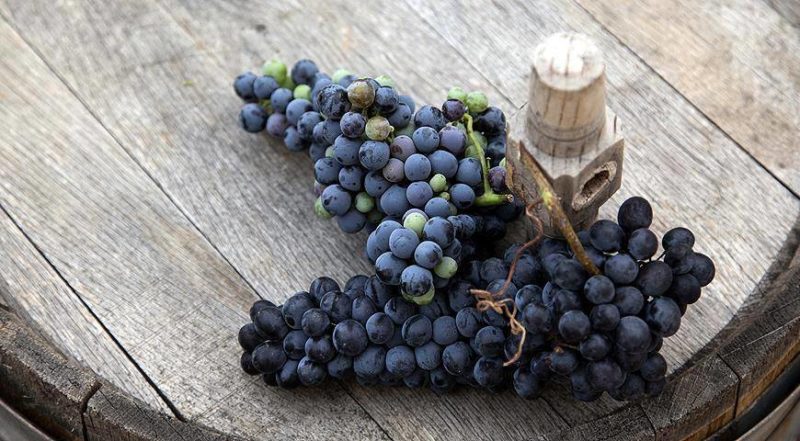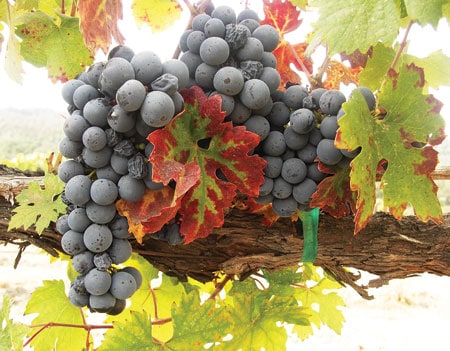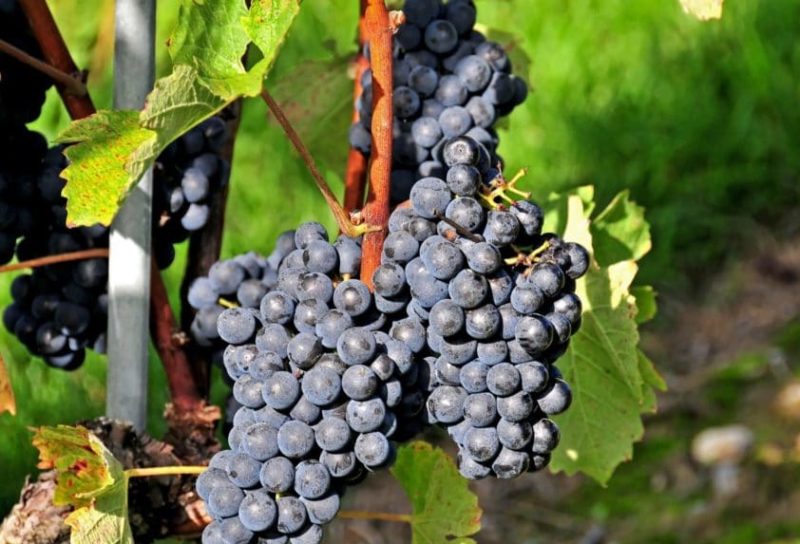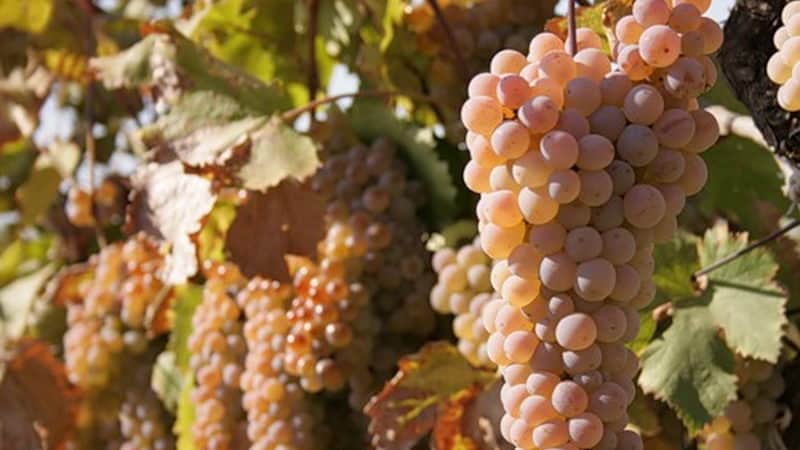Description and characteristics of grape varieties for wine
Wine grape varieties are designed specifically for wine production. Dry red, semi-sweet, and sweet wines are obtained from dark varieties; white table, dessert, and sparkling wines are obtained from white varieties. Each variety is endowed with unique characteristics. The taste of berries and finished drinks depends on the climate and area in which the crop is grown. We will tell you more about everything in this article.
Features of wine grape varieties
Grape wines are prepared from technical varieties, which, unlike table wines, have a less presentable appearance. The chemical and mechanical composition of berries depends on the varietal characteristics and growing conditions.
Fruits of technical varieties accumulate sugar and contain a moderate amount of acid. Drinks made from berries with low sugar content and minimal acidity are inexpressive. The optimal ratio of sugar and acid for white wine is 19:8, and for red wine – 7:3.
There are a number of universal varieties that are suitable for making wine: Augusta, Brown violet, Dewdrop, Buffalo. White table drinks made from Chardonnay have fruity and citrus tones. For the production of wine products, mainly white-berry Western European grape varieties are used: Crystal, Chardonnay, Riesling. Of the dark European ones, the best are considered Cabernet Sauvignon, Shiraz, Nebbiolo, Tempranillo.
The main components of berries are sugar, flavonoids, acids and vitamins. Fermentation occurs naturally.The waxy coating on the skin attracts microorganisms, including yeast. When the berries are crushed, fermentation begins immediately. Yeast reproduces and feeds on sugar, releasing digestive enzymes to break it down.
There are about 20 thousand table grape varieties. Their characteristic features:
- heavy or loose bunches;
- delicate dark, yellow-green, amber, pink peel;
- dessert taste;
- balance of sweetness and acidity;
- dense crispy pulp;
- medium and high frost resistance;
- the berries are used for fresh consumption.
Technical varieties have the following features:
- small evenly colored berries;
- thick or thin skin;
- discreet appearance;
- medium bunches;
- high frost resistance (up to -40°C);
- resistance to fungi and pests;
- ease of care;
- The fruits are used to make wines, cognacs, wine materials, juices, compotes, and raisins.
Universal varieties are included in a separate group and combine table and technical qualities. Halva, sherbet, bekmes, churchkhela, honey, syrups, marinades, and jam are prepared from the fruits. Processing waste is used for the production of alcohol, enanth ester, oil, vinegar, tartaric acid, enotanin, feed yeast, and enotan dyes.
The world's best grape varieties for wine

Red grape varieties are used to produce dry red, semi-sweet, and dessert wines. Dry wine made from red grape varieties has a more complex taste and aroma than white wine. The seeds contain tannins, which give red wines an astringent flavor. During active fermentation, the wort becomes dark red, tart with a characteristic aroma.
Reds
The most famous varieties for making red wines are Cabernet Sauvignon and Pinotage.
Cabernet Sauvignon

Cabernet Sauvignon is a French technical grape variety common in Bordeaux. Grapes are grown in Bulgaria, Italy, USA, Argentina.
The clusters are medium-sized, cylindrical-conical, loose, weighing 73-78 g. The berries are medium-sized, round, dark blue. The skin is thick and dense. The pulp is juicy, colorless. The taste is harmonious with a nightshade flavor. The average weight of 100 fruits is 90-120 g. Each berry has 1-3 seeds.
Cabernet Sauvignon is the king of grapes. It produces high-quality wine with a recognizable taste and aroma. Aging in oak barrels refines the taste of the drink and adds vanilla and cedar notes. Fruity tones of the unoaked wine include blackcurrant, plum and blueberry. Cabernet goes perfectly with heavy meat dishes.
Wines from Cabernet Sauvignon are stored in cellars for decades and only benefit from this. Harsh tannins are smoothed out and subtle aromas are enhanced. The aroma of black currant acquires new notes: leather, cedar, violets, earth.
Pinotage

Pinotage is a medium-ripening red variety. Widely distributed in Canada, South Africa, Zimbabwe, USA, Brazil, New Zealand, Australia.
The clusters are medium in size, loose, cylindrical or cylindrical-conical in shape. The fruits are small or medium sized, oval in shape. The skin is thick, dark blue. The pulp is juicy, colorless.
With proper processing, diverse wines are obtained. Young Pinotage delights with a refreshing fruit and berry taste with a slight sourness. Aged Pinotage produces a deep, velvety, tannic flavor with hints of spice and dark chocolate. The variety is also used for the production of sparkling and rose wines.
Aging in oak barrels reveals the taste and aroma of the drink in a new way; notes of black berries appear, mixed with tones of spices and bananas.
The color varies from light red to violet-red. The drink smells of leather, smoke, blackberry, and oak. The taste contains notes of raisins, chocolate and marshmallows. The aroma contains notes of pine needles, violets, cinnamon, and acrylic paint. “Noble rot” gives the wine an aroma of burnt earth and burning.
Pinotage is served with dried antelope meat, Dutch pork sausages, Indian spicy rice, curry, lamb, kumquat, marula, rambutan jam, and also as a digestif (after meals).
Reference. In addition to wines from Pitotage and Cabernet Sauvignon varieties, drinks from Merlot, Grenache, Mourvèdre, and Tempranillo grapes go well with meat dishes.
What grapes are dry red wine made from?
The most famous varieties for making dry red wines are Shiraz (Syrah), Malbec, Tempranillo.
Shiraz

Shiraz is a noble red grape variety that has been known since the times of the ancient Romans and Greeks. The variety's homeland is France, the Rhone Valley. Here it is considered the main variety for making wines: Cote Rotie, Hermitage. Shiraz is also popular in the south of France, where it is included in most blends.
The grape clusters are of medium size, cylindrical-conical in shape, and of medium density. The fruits are oval, black.
In the north of the Rhone Valley, Shiraz produces dark wines and traditionally adds a splash of Viognier for flavor. The drink turns out dark and tannic. In Australia, drinks have a slightly different taste - they are dense, strong, with the aroma of black pepper and spices.
The classic taste of the drink from the Shiraz variety has notes of currants, chocolate, blackberries, leather, smoke, and earth. The color is dark purple, almost black.The wines pair with game, red meats and cheeses.
Malbec

The clusters of Malbec grapes are medium or small, conical in shape, loose. The berries are round, dark blue or black. The skin is medium thick. The pulp is juicy and melting. Juice yield is high - 90%. The color of the juice becomes inky.
Malbec is ideal for making wines with a rich flavor and rich aroma of spices, chocolate, marmalade, cherry, plum, oak and vanilla.
The fruits, collected in the Uco Valley (Argentina), have moderate acidity and contain enveloping tannins. The color of the drink is deep and rich, and the taste is balanced.
In the southern regions of Mendoza, the grapes ripen early and are characterized by high sugar content and low acidity.
Wines made without aging in a barrel are recommended to be consumed within a year. Aged for 3-4 months, they are stored in bottles for 2-3 years, more than a year - 10 years.
The aroma of Malbec wine varies depending on the climate. Growing grapes in the cool climate of France produces drinks with raspberry and cherry flavors. Argentine drinks are scented with plum and blackberry. The aged wine contains notes of coconut, tobacco and vanilla.
Reference. Malbec is served with hard cheeses, red meat, pasta with tomato sauce. Supply temperature – +17…+21°С.
Tempranillo

Tempranillo is a Spanish wine grape variety. The clusters are compact, cylindrical-conical, weighing up to 700 g. Young bushes are prone to peas, especially in cold regions. The berries are small, the skin is medium thick, black and blue in color. The pulp is moderately dense and dark.
The variety contains anthocyanins, thanks to which drinks acquire a rich color, as well as a tart and velvety taste.The aroma contains notes of tobacco, cherry, black currant, strawberry, prunes, and chocolate. Berry tones predominate in young wine.
The wine, aged in barrels, has coconut and vanilla notes. Winemakers in Ribera del Duero age the wort in old French oak barrels, which gives the drink a fruity taste and a pleasant oak aroma.
In Spain, Tempranillo, aged in traditional oak barrels, turns orange, has a rich flavor and a light structure. It is served with jamon, sausages and grilled vegetables, pizza, lasagne, pasta with tomato sauce, tacos, burritos, chili, stewed beans, fried lamb with red currant jelly.
Sweet varieties
Sweet red wines are produced in several ways:
- from aromatic varieties - Brachetto, Muscat, Bual, Aleatico, Grenache Noir;
- by late harvesting and withering of berries;
- using fruits with noble mold.
The production processes of sweet red wine are complex. The winemaker stops fermentation before all the sugar has converted to alcohol. The most famous sweet wines are Lambrusco, Banyuls, Abbazia.
Aleatico

The clusters are medium, cylindrical-conical, dense or medium-loose, weighing 130-150 g. The berries are round, black, with a bluish bloom. The skin is thick, the flesh is juicy and green. The taste is pleasant, the aroma is nutmeg. Sugar content - 20-26%, acidity - 5.5-6.5 g/l.
Their grapes are used to make dessert vintage red wine with a pleasant muscat tone, and when combined with Cabernet Sauvignon, Morastel, Saperavi - port wine with an oily, unique bouquet.
Tasting rating of dessert wine - 9.7 points out of 10.
Grenache Noir

The second name of the variety is Garnacha Tinta. This is the oldest wine grape variety of the Western European ecological and geographical group.The berries contain a lot of sugar - up to 29% and 6-7 g/l acid. The aroma is pronounced varietal. The berries are used to make rose wines. When blended with Grenache Blanc and Grenache Gris, fortified sweet wines are obtained, popular in Spain.
White
From white varieties The grapes produce white table, semi-sweet, dessert, and sparkling wines.
Rkatsiteli

White grape variety with high yield. Sugar content of berries is 20-24%, acidity is 7-8 g/l. The fruits are medium in size, oval in shape, thin skin, golden yellow with brown spots. The pulp is juicy. The ripening period is 150 days. Productivity - 110-160 c/ha.
Famous white wines are produced from Rkatsiteli using Kakheti and European technologies, indicating the place of origin: “Kotekhi”, “Tsinandali”, “Kardenakhi”, “Gurjaani”, “Kakheti”, “Vazisubani”, “Napareuli”, “Tibaani”, port “ Kardanakhi" and Madeira "Hirsa".
Grapes are also used to make white table wines, cognac and grape juice.
Chardonnay

Chardonnay is a world famous French wine. technical grade. The clusters are medium-sized, cylindrical-conical, weighing 90-95 g. The berries are round or oval, the skin is thin, white-green with a golden tan and small brown dots. The pulp is juicy, the aroma is delicate. Juice yield - 74%. Productivity - 60-80 c/ha. Sugar content - 18-23%, acidity - 8.2-11.0 g/l.
The grapes are used to make white wines with the aroma of tropical fruits, as well as sparkling wines.
Muscat white
White Muscat is a technical variety, popular in Italy, Spain, France, Bulgaria, and the USA.
The clusters are small, cylindrical or cylindrical-conical, weighing 105-450 g. The fruits are medium-sized, round, yellowish-golden. The skin is medium thick. The pulp is juicy, the aroma is nutmeg. Juice yield - 75%.Sugar content - 18-32%, acidity - 6.5-10.5 g/l.
The grapes are used to produce dessert wines with the aroma of citron and tea rose, table and sweet wines, and champagne.
Wine grape varieties for Kuban
The favorable climatic conditions of the Krasnodar Territory are ideal for cultivating the best varieties. The plantations are located in the Anapa-Taman zone. Harvesting begins at the end of July and ends in mid-October.
In Kuban, grapes are grown using covered and open methods. Experts do not name the exact number of varieties, since the vineyards are regularly replenished with new breeding developments.
The most popular varieties of culture:
- Madeleine Angevine with 15% sugar and 6.7% acid.
- Saba pearls with 16% sugar content and 7.3% acidity.
- White Chasselas occupies a leading position. The berries contain 15% sugar and 6.7% acid.
- Chaush bears fruit abundantly and requires pollination. Sugar content of berries is 14%, acidity is 6%.
- Hungarian nutmeg is characterized by high sugar content of more than 20% and low acidity of 6.5%.
- Cinsault with a harmonious taste, sugar content 18.3% and acidity 7%.
The oldest grape variety for winemaking
The most ancient grape variety is Kalabaki, or Limnio, native to the Greek island of Lemnos.. The variety is cultivated mainly in Northern Greece. The berries are dark blue in color and exude a delicate aroma. Light drinks of a rich red color with an exotic aroma of violets, cherries, herbs, oregano, ripe peaches, cranberries, and strawberries are prepared from the grapes. They turn out fresh, light, bright and appeal to those who do not like heavy tannic red wines.
Drinks from Limnio are often drunk young, but those aged for 4-7 years delight with an excellent bouquet.
Kalabaki is blended with Cabernet Franc and Cabernet Sauvignon to add tannic structure.
The drink is served with meat and fish dishes, pasta with meat sauces and soft yellow cheeses.
What varieties of wine are not made from?
Table grape varieties not suitable for making wine. The fruits are suitable for fresh consumption and have a pronounced taste, but the wines they make are mediocre.
Many amateur winemakers believe that wine can be made from any sweet grape varieties. However, experts advise choosing varieties whose berries contain 27-28% sugar and are capable of releasing a lot of juice. Only in this case the drink will turn out tasty and harmonious.
The most famous table varieties not intended for wine production, - Arcadia, Laura, Red Rose, Libya, Amethyst, Veles, Cardinal, Moldova, Agadai.
Conclusion
Wine grape varieties are red and white. The former produce dry, semi-sweet and sweet wine. These varieties include Cabernet Sauvignon, Pinotage, Shiraz, Malbec, Tempranillo, Aleatico, Grenache Noir. Table and dessert wines and champagne are produced from white grape varieties. These are Chardonnay, Rkatsiteli, White Muscat.
Many well-known varieties are cultivated in Kuban and the range is regularly expanded thanks to breeding developments. The oldest grape variety is Kalabaki, or Limnio, originally from Greece.
Table varieties Arcadia, Laura, Red Rose, Libya, Amethyst, Veles, Cardinal, Moldova, Agadai are not suitable for wine production. Drinks made from them have an inexpressive taste and aroma.